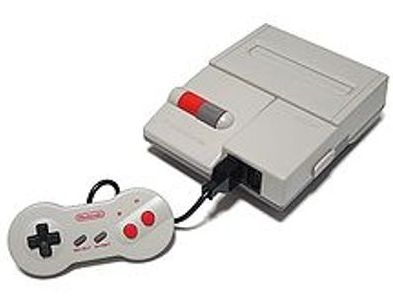


Family Computer (model HVC-101)
Packaging artwork of the AV Famicom
The HVC-101 model of the Family Computer was a redesign of the original HVC-001 Family Computer video game console released by Nintendo in Japan in the early 1980s. While officially called the Family Computer, exactly the same title as the original, it was also marketed as the AV Famicom (AV仕様ファミコン Eibui Shiyō Famikon) or New Famicom to distinguish it from the original system. It was released in Japan on December 1, 1993 and retailed for ¥6800. Like the original model, it is commonly referred to by the nickname "Famicom". It was stylistically similar to the NES-101 model released in North America at roughly the same time. It was produced until September 2003.
The AV Famicom
The HVC-101 model was designed to address two major design flaws of the original HVC-001 model. The original HVC-001 featured hardwired game controllers; users who wished to add additional, specialized controllers were forced to make use of the deck's single expansion port (which was retained on the HVC-101). In bringing NES-style removable controllers to the HVC-101 model, Nintendo removed the microphone which had been originally included on the second controller in place of the "Start" and "Select" buttons. The microphone was originally intended to introduce extra functionality for certain games, but in practice, very few games had ever made use of it. The redesigned controllers have the Nintendo part number HVC-102 and are equivalent to the NES-039 controllers for the NES. However, the HVC-102 controllers have much shorter cables than the NES-039 controllers.
The AV Famicom with the Family Computer Disk System.
Secondly, the HVC-001 model featured audio/video output via RF modulator only. By the early 1990s, many Japanese television sets featured composite input jacks. The HVC-101 replaced the HVC-001's RF output connector with the same AV connector used in the Super Famicom, thus the name AV Famicom. This represented the biggest difference between the Japanese HVC-101 and the North America NES-101, which included only RF modulator output functionality (even though the original NES-001 had composite as well as RF modulator outputs). However, Nintendo sold an external RF modulator (HVC-103) for those who wished to connect their HVC-101 to a TV which lacked a composite video input. In an unusual move, Nintendo did not package an AV cable or AC adapter with the HVC-101, which either had to be purchased separately or shared with a Super Famicom.
The HVC-101 also featured a slightly different case design from the NES-101 in order to remain compatible with the Family Computer Disk System, as the area around the cartridge slot of the HVC-101 is flat rather than convex. This allows users to insert the large RAM Adapter cartridge required to use the Disk System accessory.
Console revisions
There are two known revisions of the NES-101; both have redesigned circuit boards that improve video output quality. The first has a Nintendo AV multi-out port (the same used in the Super NES, Nintendo 64, and GameCube) that replaces the RF jack completely. The other looks exactly the same as the rest with the RF video output jack and channel select switch, but with excellent video output quality. These versions were replacements for those who sent their original NES-101 systems to Nintendo with a poor quality video complaint. These models are extremely rare as they mostly came as replacement units from Nintendo, but the revised AV model was also found in stores such as Meijer and Radio Shack. All PAL units, model NESP-101, were shipped with the revised motherboard and cleaner RF output, but video output was underclocked from the 60Hz used in NTSC models to the PAL standard of 50Hz. The PAL versions also do not have a channel select switch. They also have some minor cosmetic differences. On NTSC top loaders, the RF out panel is made from the same light gray plastic as the top shell. On the PAL version, the RF out panel is made from the same dark gray plastic as the base shell. The PAL console also lacks a 1800 service hotline sticker.










